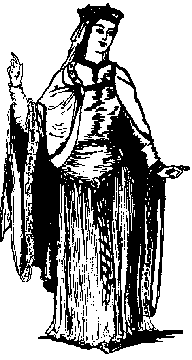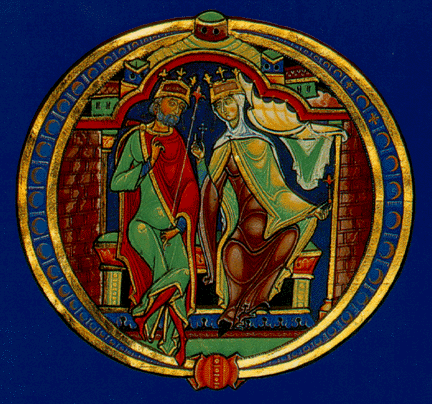

Clothing is an important concern for people in the SCA, since it is the main way we can present ourselves as our persona, and it is the only requirement for going to an SCA event (you must make "some attempt" at wearing clothing from the 16th Century or earlier).
In general, it seems that Jews dressed in the same style as their fellow countrymen (and women) - this is why the "badge of shame" and other distinguishing marks were later required by the Church so that Christians wouldn't "accidentally" interact with Jews.
In Northern European countries, this distinguishing badge was required since 1215. The rulers of Spain, realizing what a hardship this would be for their valued Jews - and how profitable it might be allow monetary considerations to buy exemptions - did not enforce this law until Peter the Cruel (?). The badge is in the shape of a ring or wheel, yellow, and worn on the breast, shoulders, the back, the hat, or two positions. In 1257 a Papal Bull required that Jewish women wear a veil with two blue stripes.
In 1396 Juan I of Aragon requied Jews to wear a gramalla or long outer gown which would cover their toes. In 1412 the Jews (and Moors) of Valladolid were to "wear long robes over their clothes as low as their feet, and are not to wear cloaks; and in all cities, towns and places, they are to wear their distinctive red badge.... All Jewesses and Moriscas...shall wear long mantles, reaching to their feet, and cover their heads with the same." In addition, Jews and Moors were fobidden to wear clothing that cost more than 30 maravedis; if they were caught with more expensive clothes, they could lose the clothing, receive a hundered lashes, and lose their property to the king's treasury.
Images from Jewish illuminated manuscripts, such as the Golden Haggadah (c.1320), show Jews dressed like other medieval Europeans (even if they're depicting Biblical figures - Egypt's Pharaoh looks almost exactly like some of the medieval French kings!). In the Golden Haggadah, the men appear to be wearing tunics and mantles, and the women, either two layers of tunic-dresses or cotehardies with side lacing, and a simple head veil. Fifteenth century Spanish Christians are described wearing mantas (cloaks or capes) and sometimes a tapado, a veil revealing only the left eye.
Of course, Jewish poets celebrated clothing along with almost every other subject:
Wheat or barley. I spread it out like a
tent in the dark of the night, and the stars
shine through it: through it I see the moon and the
Pleiades, and Orion,
flashing his light. I am afraid of counting
all its holes, which are shaped like the
teeth of a saw. No thread can hope to mend
its gaps with warp and woof. If a
fly landed on it with its full weight, it
would quickly regret its foolishness
O God, give me a robe of glory in
exchange - This would be properly
tailored!
A Jewish man might wear a turban on his head, particularly in Muslim-controlled areas. But see When Jews Wore Turbans for a further discussion. The hat that Jewish men were most known for is a pointed cone-like hat called Judenhut, pileus cornutus or simply "Jewish Hat". It may have dervied from the Persian kalansuwa hat worn by non-Muslims in Arab countries, and has been found in illustrations as early as 1097. It was usually yellow. It came to be a proud symbol of Judaism, unlike the Badge. It may have fallen out of favor by the 13th Century, however, when Jews dressed so much like their neighbors that the Church declared the Badge necessary.
People living in Spain enjoyed wool garments made from a special breed of sheep, called the merino. This sheep was brought to Spain by the Muslims, presumably from North Africa. See Spain's Golden Fleece, a book on the wool trade.
Of course, quien se levanta de manaña, viste en seda (the early riser will be dressed in silk). The Muslims also brought with them mulberry trees to grow silk worms on. Halima de la Lucha has an excellent article on fabrics and Textiles of Islamic Spain.
Cloth was measured in ells (each measuring about 8 hands or 3 feet long). In Toledo, clothing was washed in the river, where some people also bathed.
It is possible that Jews had special clothing for fighting in. "Jewish battalions with distinctive uniforms fought in both the Christian and Moslem armies." - from the "Who are the Sephardim?" page.
One plate from History of Costume shows a "Rich Jew", 12th Century.
Lady Morrigan sells a Spanish cotehardie and sideless surcoat combination that appears to be appropriate to the period. This sort of outfit is seen in some paintings.
Jewelry
Toledo is also known for its Damascene jewelry, made by inlaying gold threads over blackened steel. Some authors claim that this became very popular in the 1400s, though I have yet to see any pictorial evidence of it. Modern Damascene jewelry can be seen here.
Appearance
Jews and Muslims were also known for their frequent bathing and attention to hygiene. In Spain their baths were known as bañuelos. The Jews had the saying, La limpieza es junto a riqueza (cleanliness is next to wealth). The palaces at Granada even had a sort of "flush toilet" where water flowed beneath marble seats. Partially as a reaction against these enemies of Christendom, some Christians preached that physical dirtiness was a sign of spiritual cleanliness, and discouraged bathing. This is probably the cause of modern conception that Medieval people were bathed at baptism and at death, and no time in between.
Jewish men were known for wearing long hair and beards. The law of Valladolid in 1412 proclaimed that Jews (and Moors) were not to shave their beards or cut their hair, "but are to wear them long as they grow naturally, as they were formerly accustomed" (from Rubens 1967).
Selected References
Alfred Rubens, A History of Jewish Costume, 1967, Funk and Wagnalls, Newy York.
Anita Diamant, The New Jewish Wedding, 1985, Summit Books, New York.
Illuminations: A Jewish Calndar from the British Library, 1997, Pomegranate Calendars and Books, Rohnert Park, CA.

This page is part of Chaiya's Sephardic World, a website devoted to the history and culture of Jews in Medieval Spain. The site is centered around the fictional SCA persona of Chaiya bat Avraham Toledano, created by Stacy Braslau-Schneck, the author of these pages. Chaiya is a Jewish lady living in Toledo in the 1230s. The SCA, or Society for Creative Anachronism, is an educational organization devoted to researching and recreating the Middle Ages.
I do not claim to be an historian, only a hobbyist. All errors are mine, all text is copyrighted to me, and all comments are welcome! "Yad/Return" image ©2001 Ilene Winn-Lederer
![]() Return to Chaiya's Sephardic World
Return to Chaiya's Sephardic World
This page hosted by
![]() Get your own Free Home Page
Get your own Free Home Page